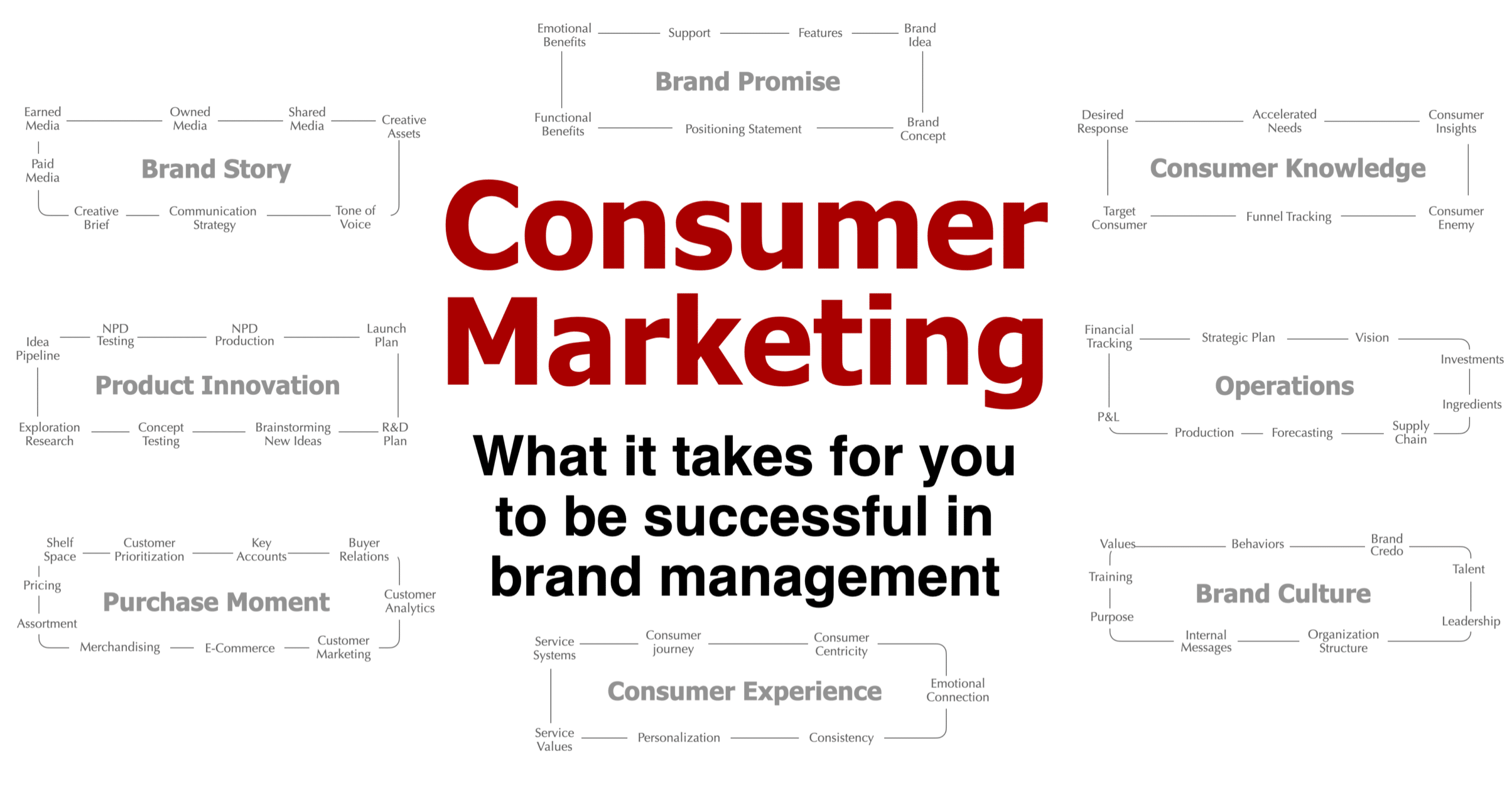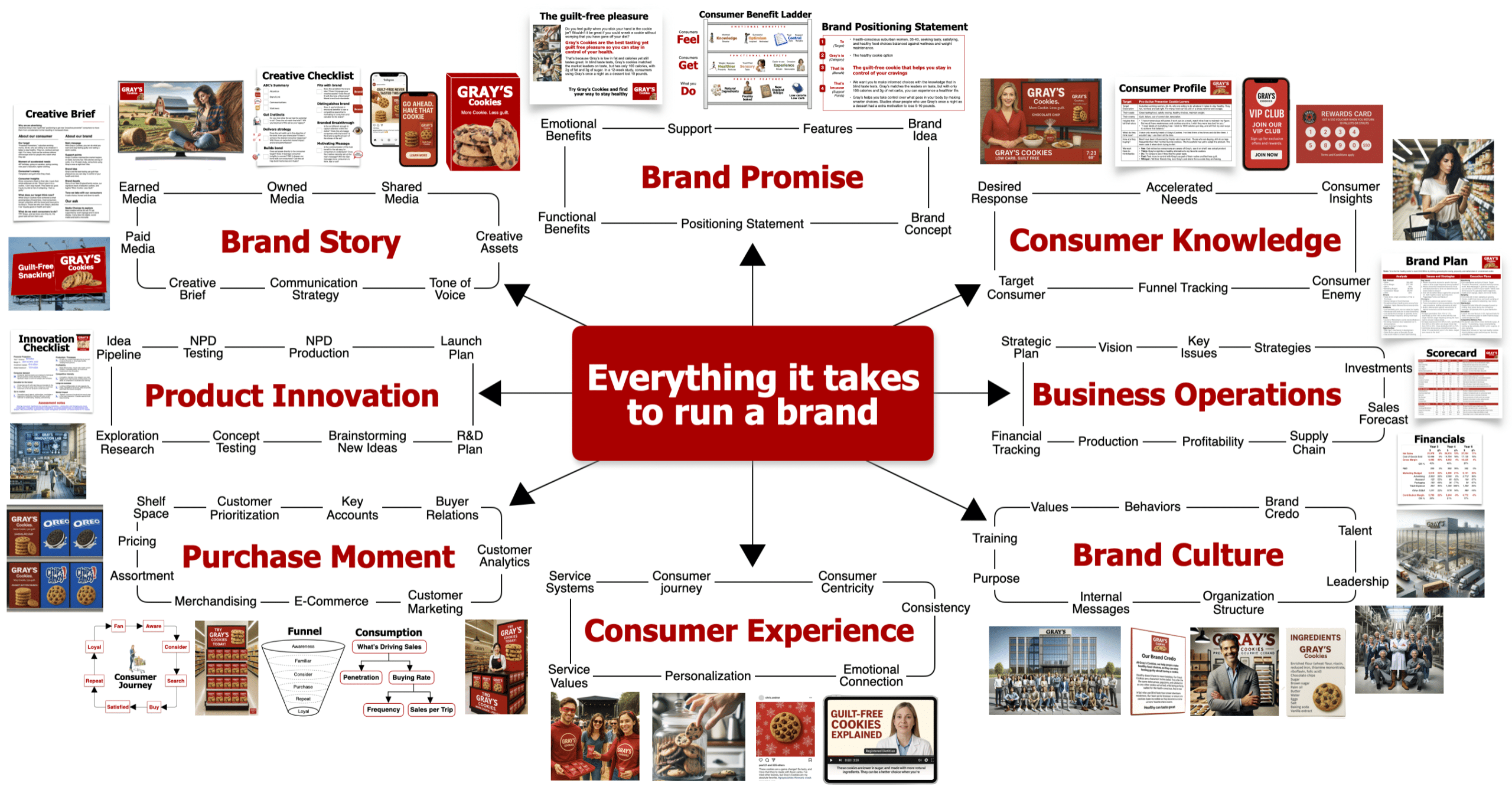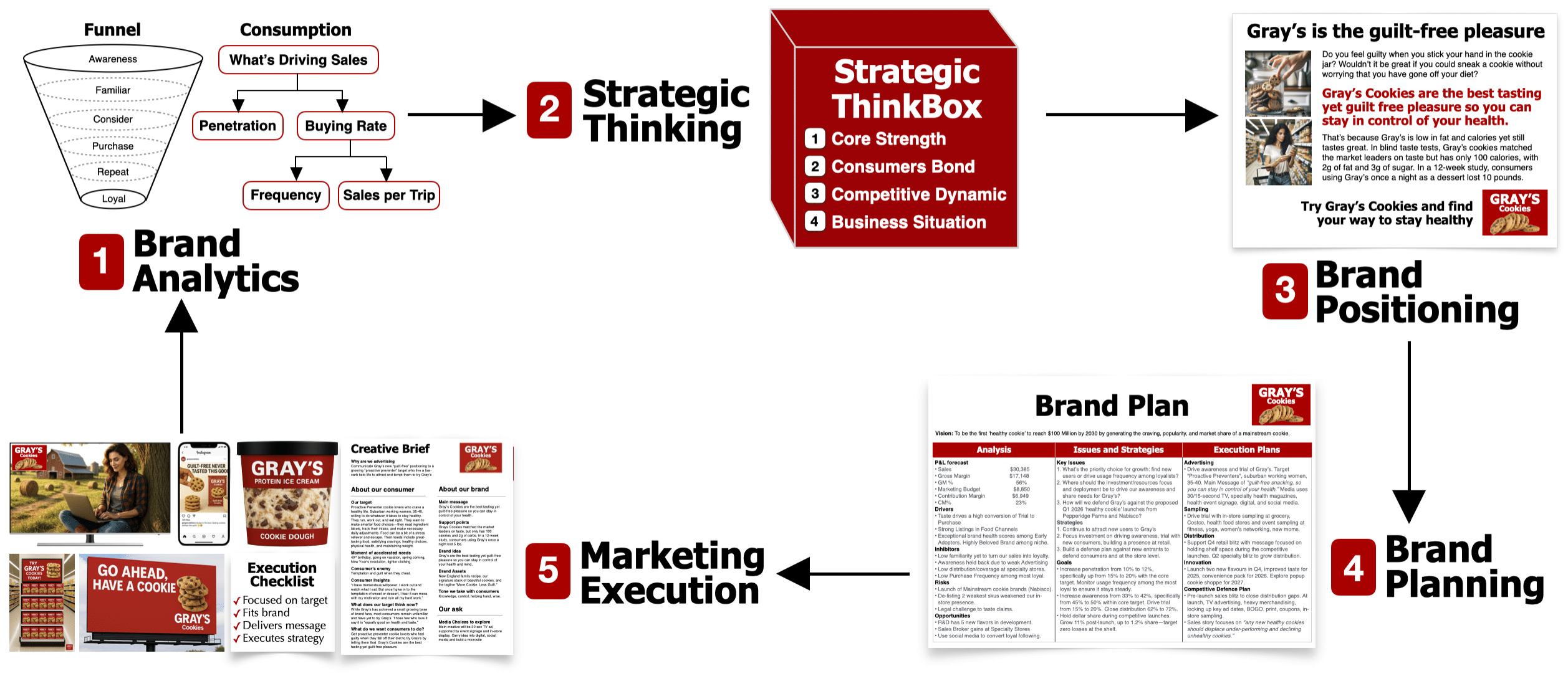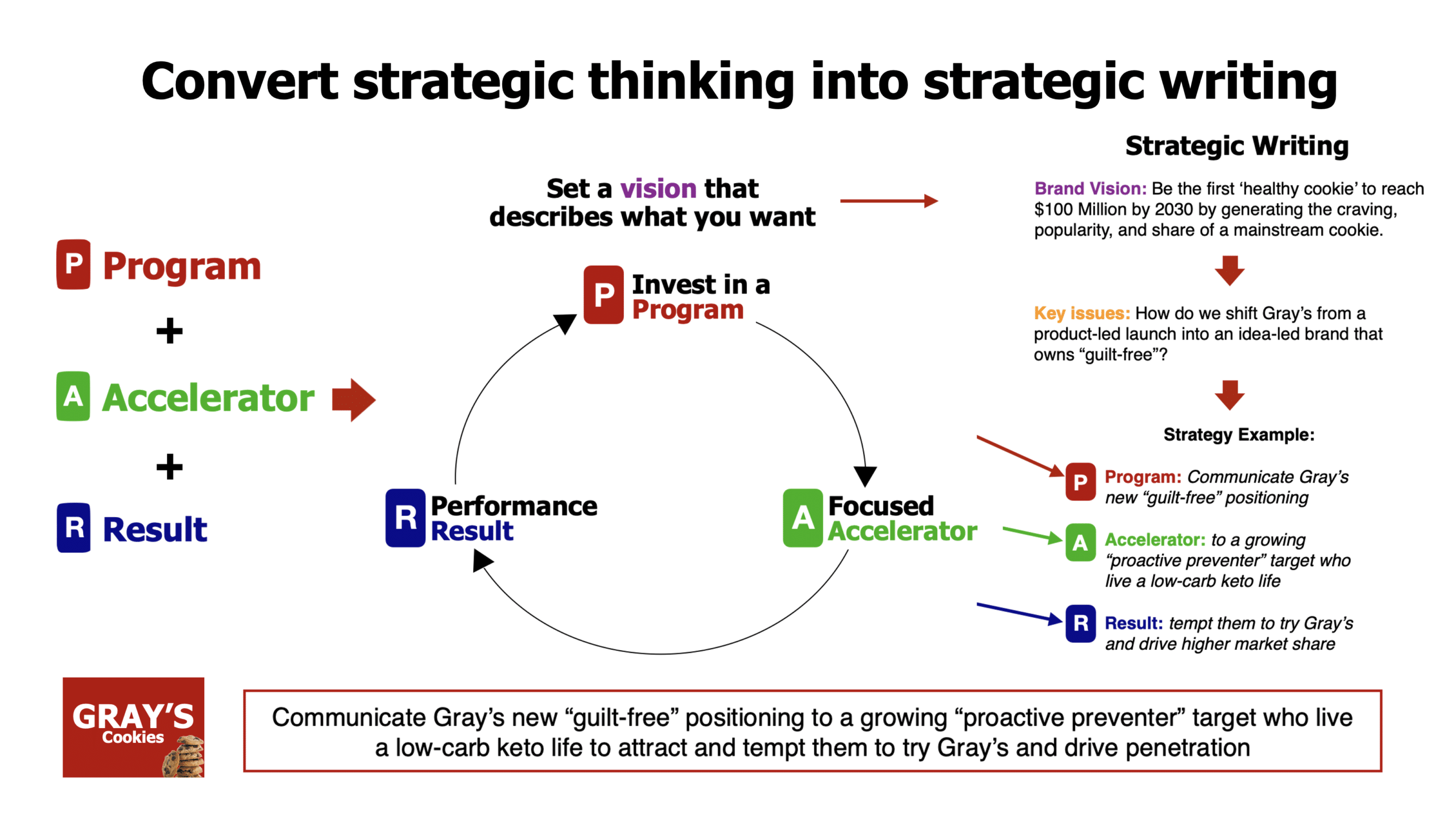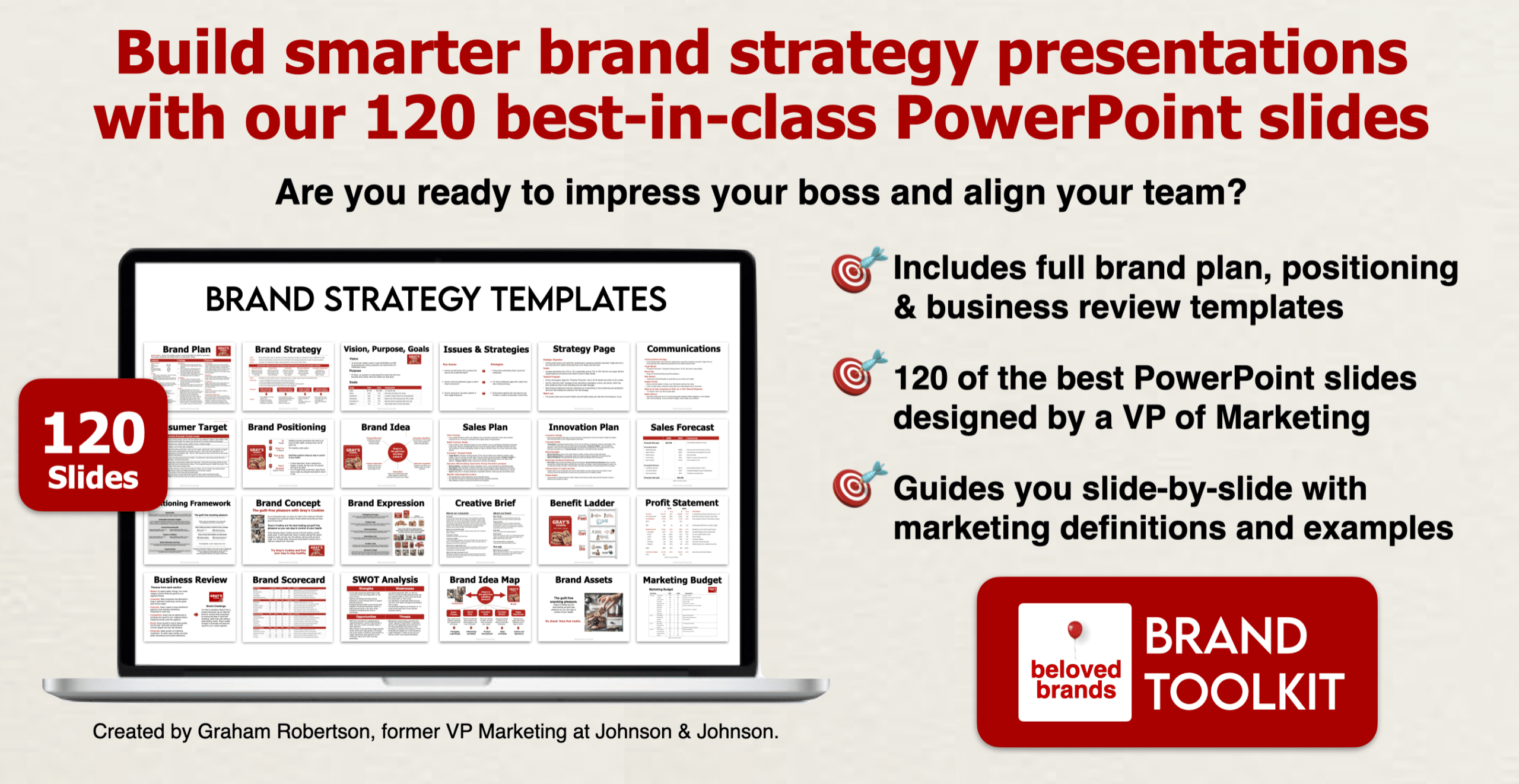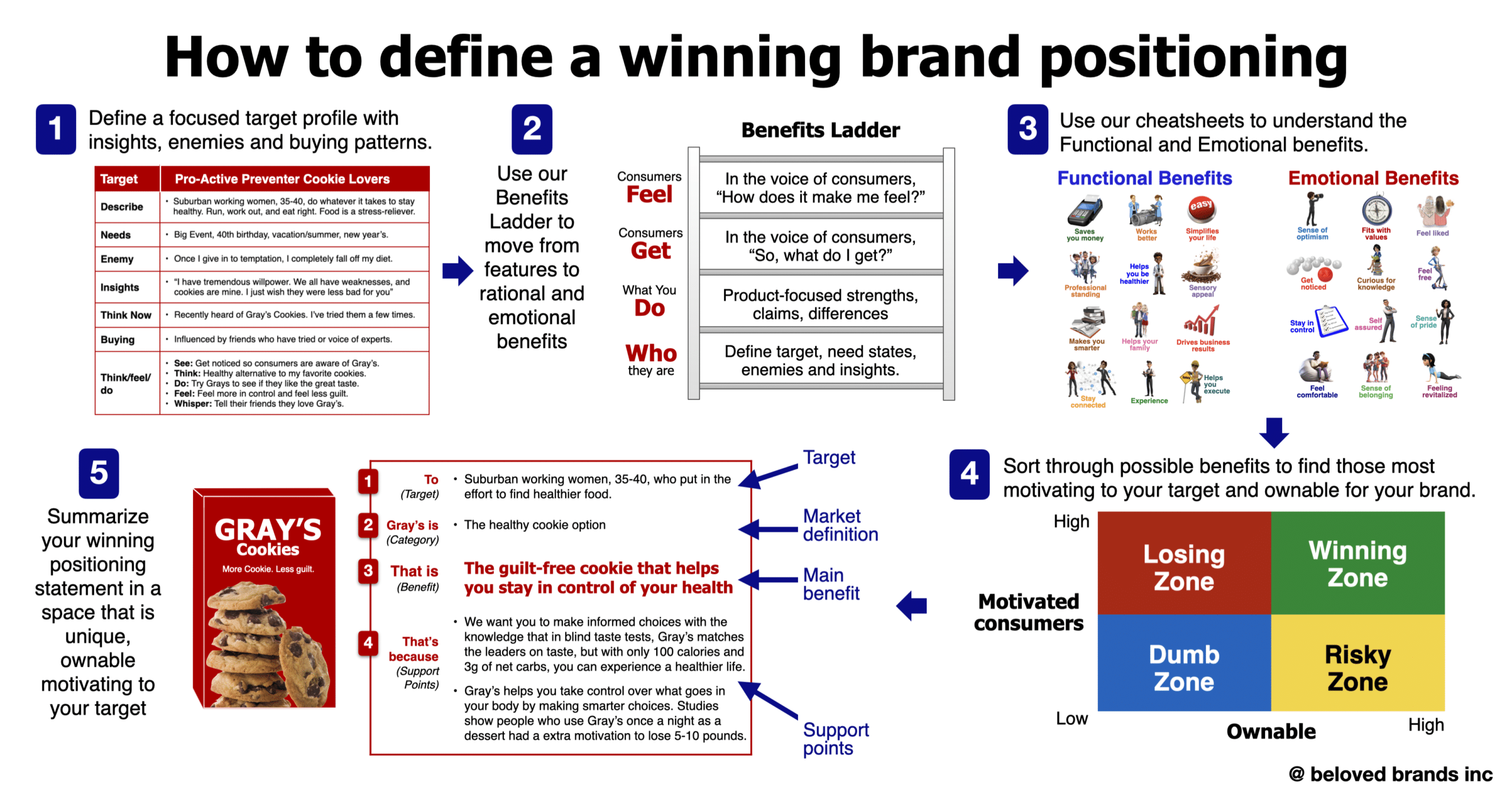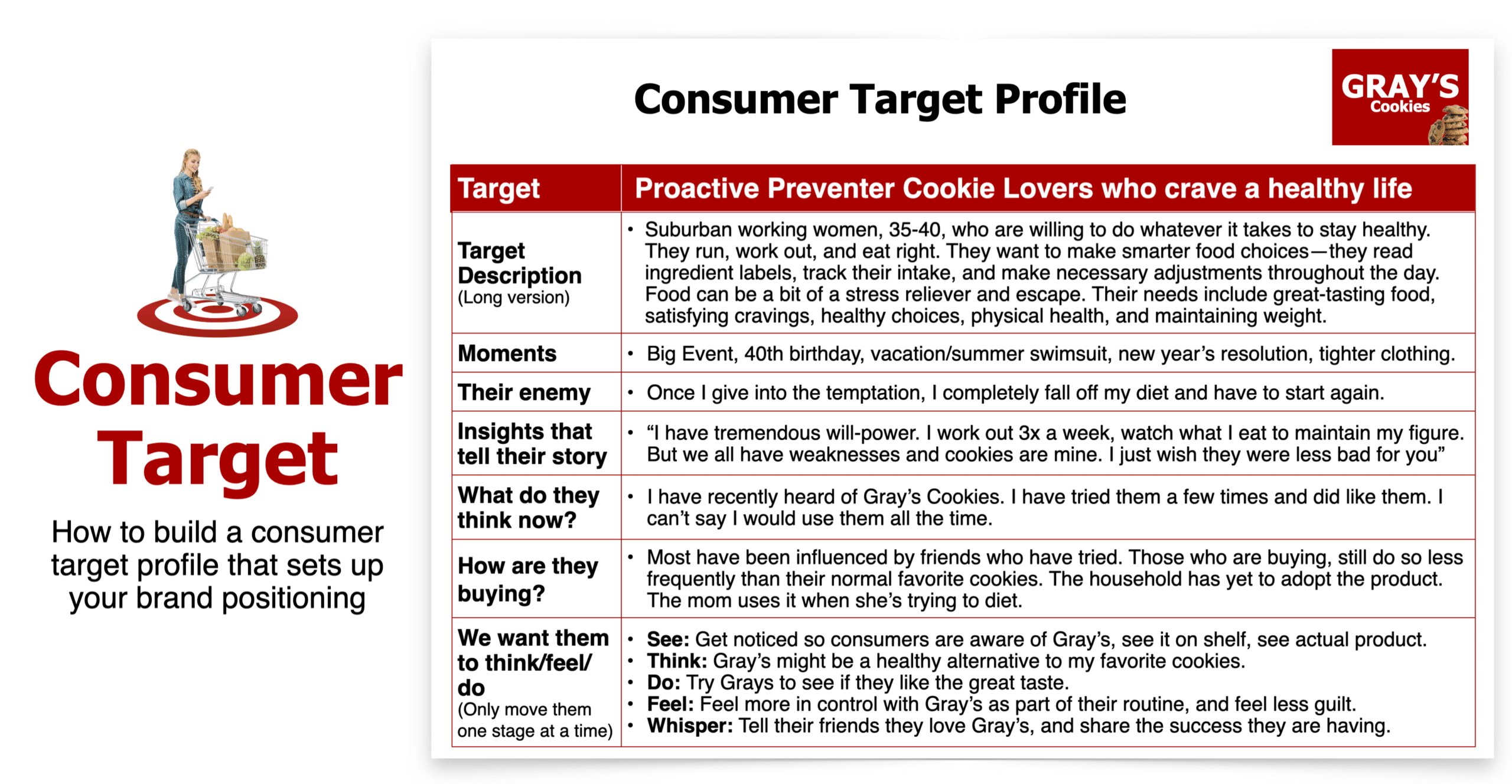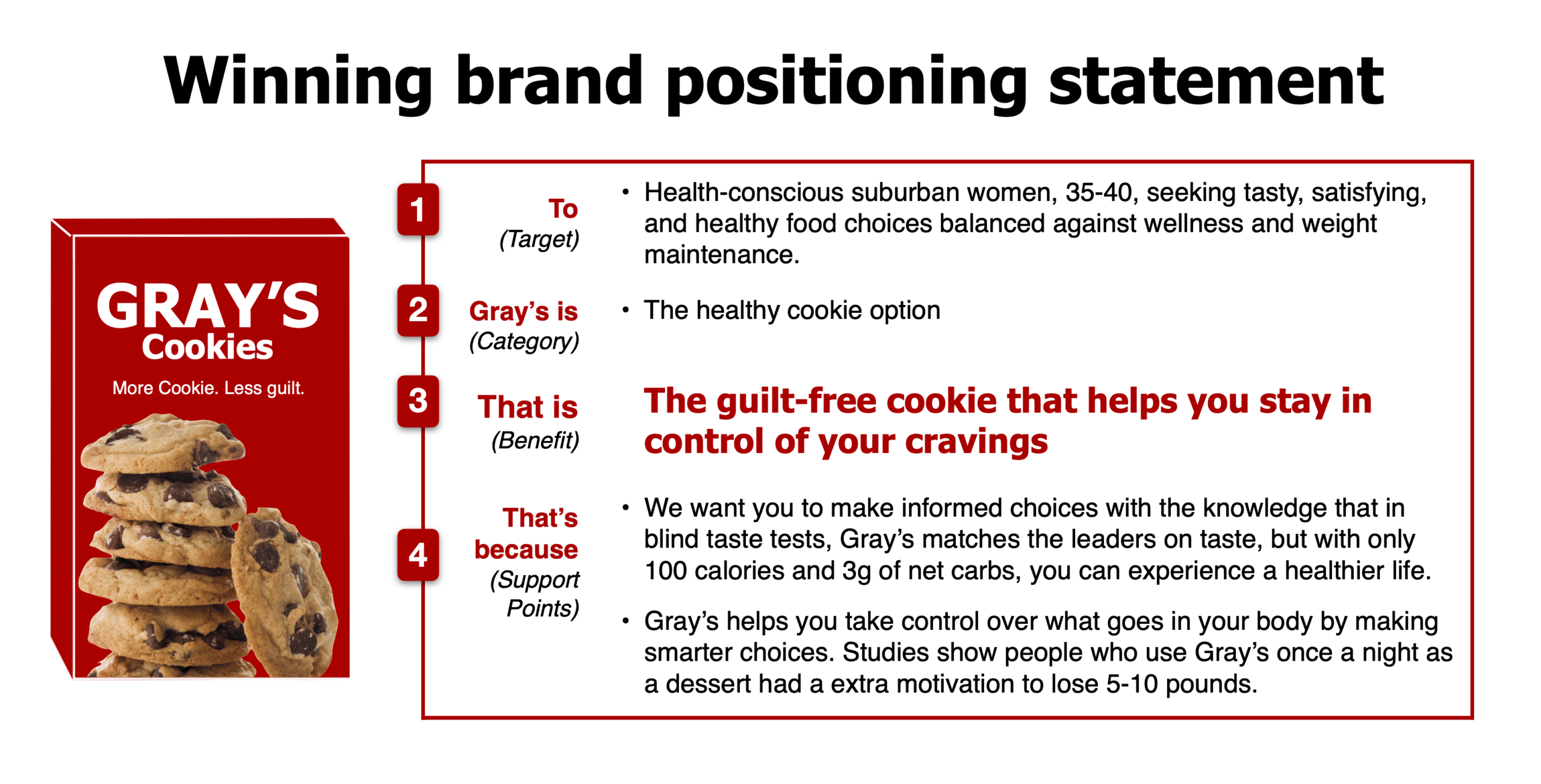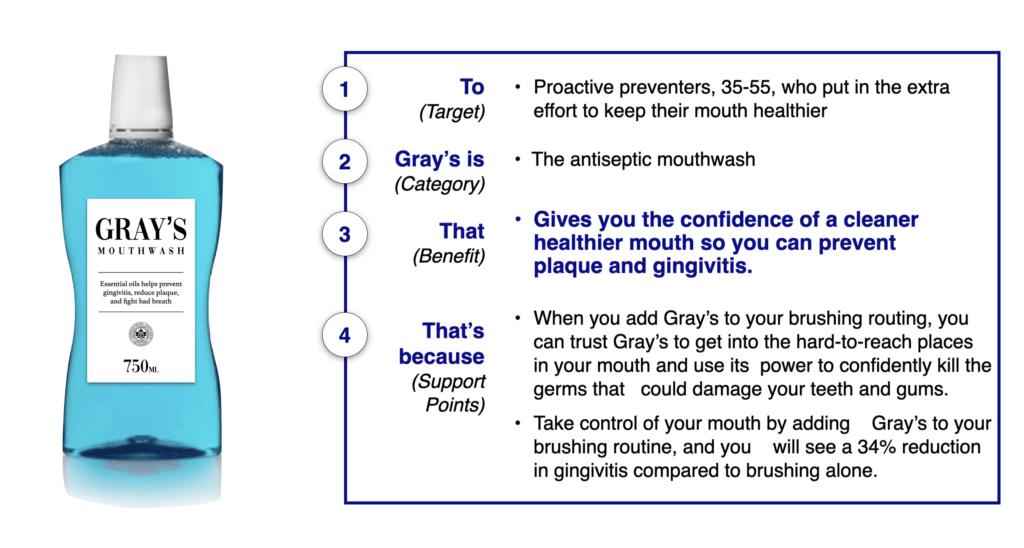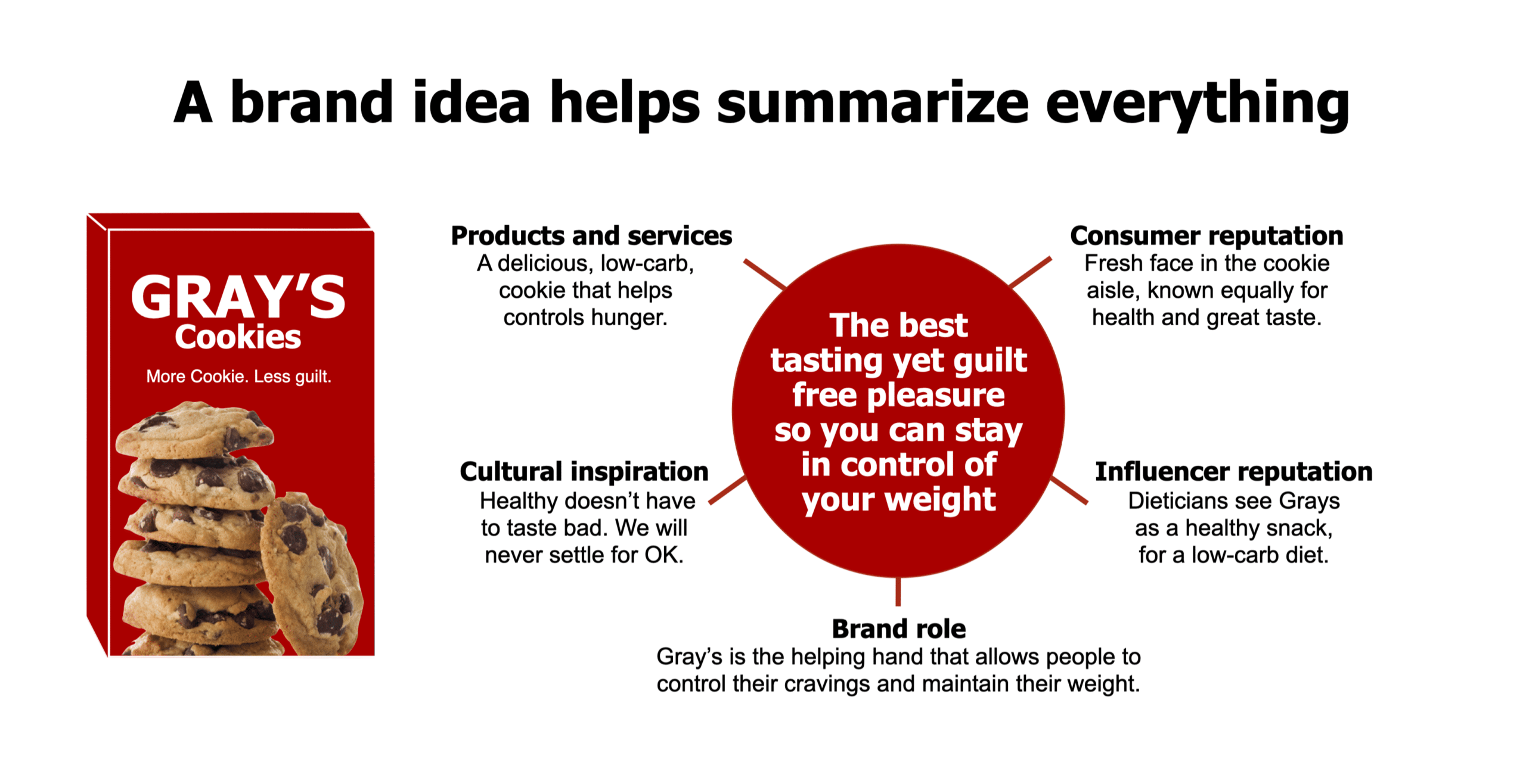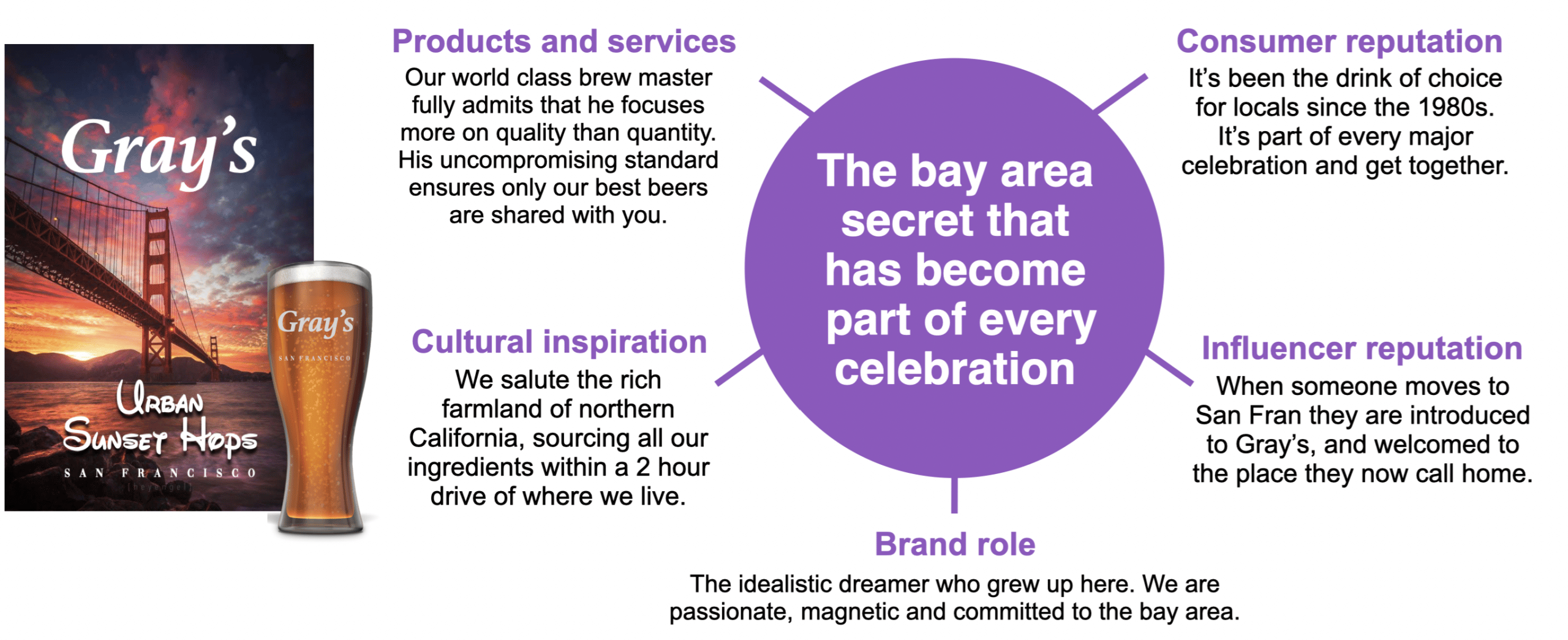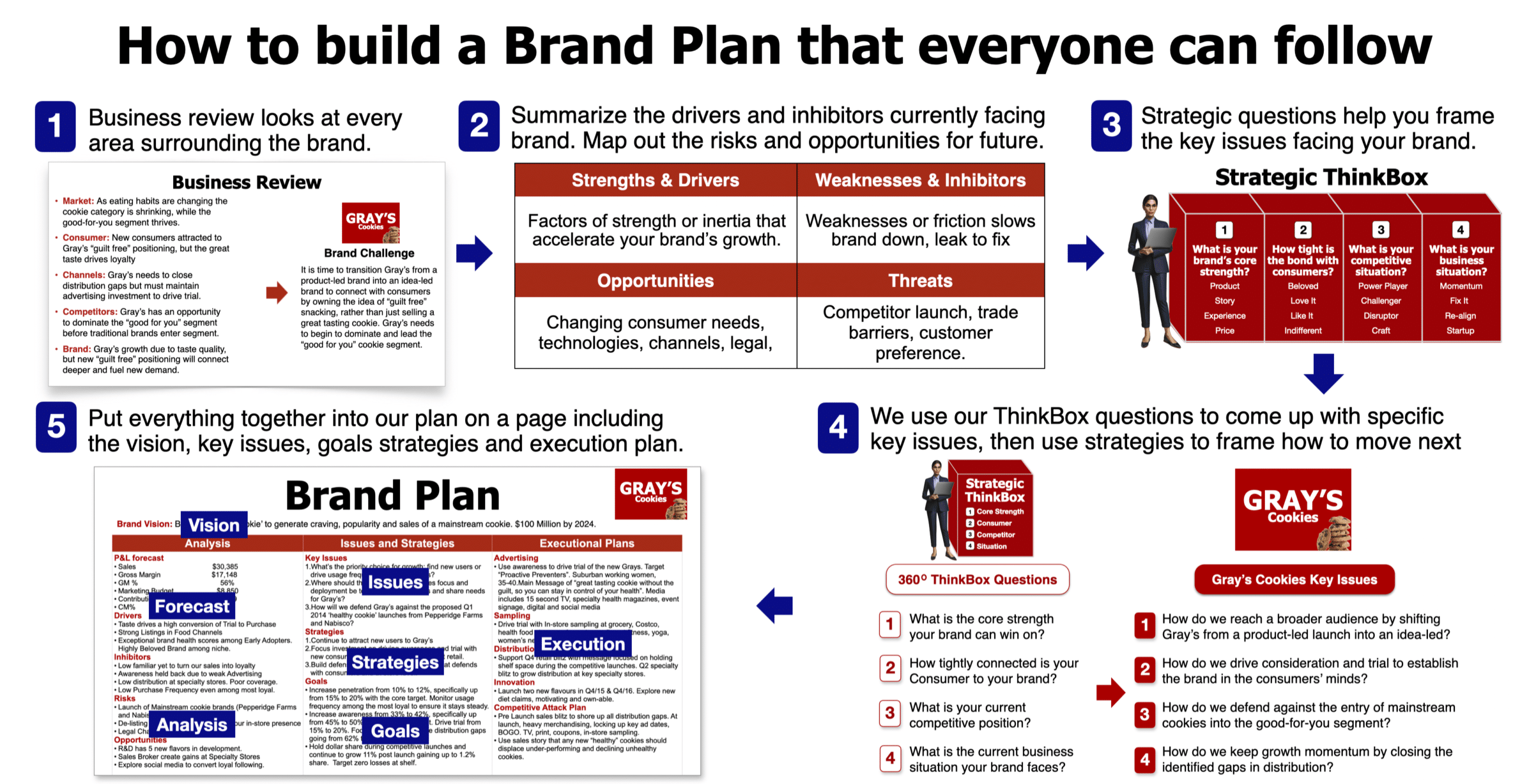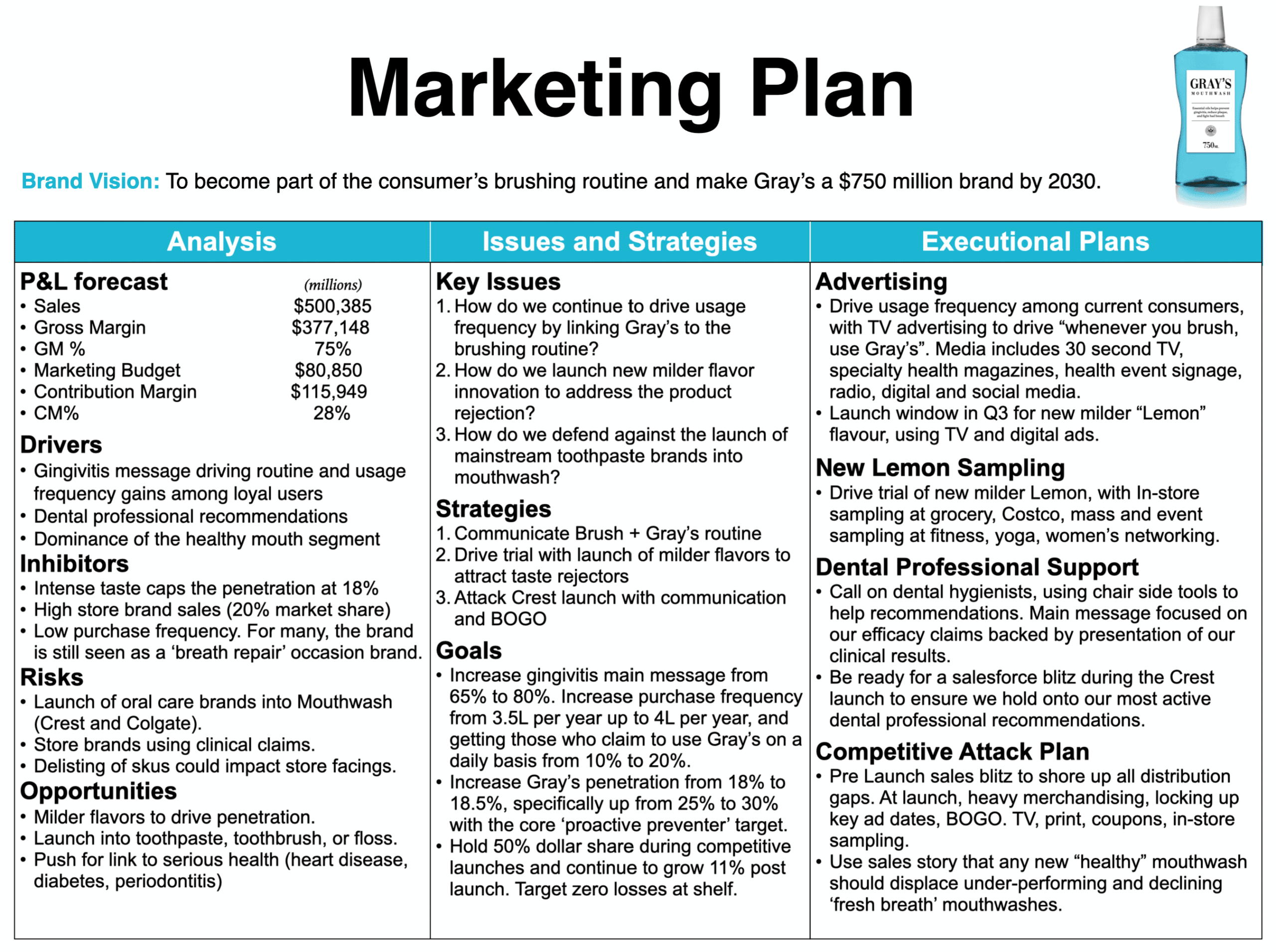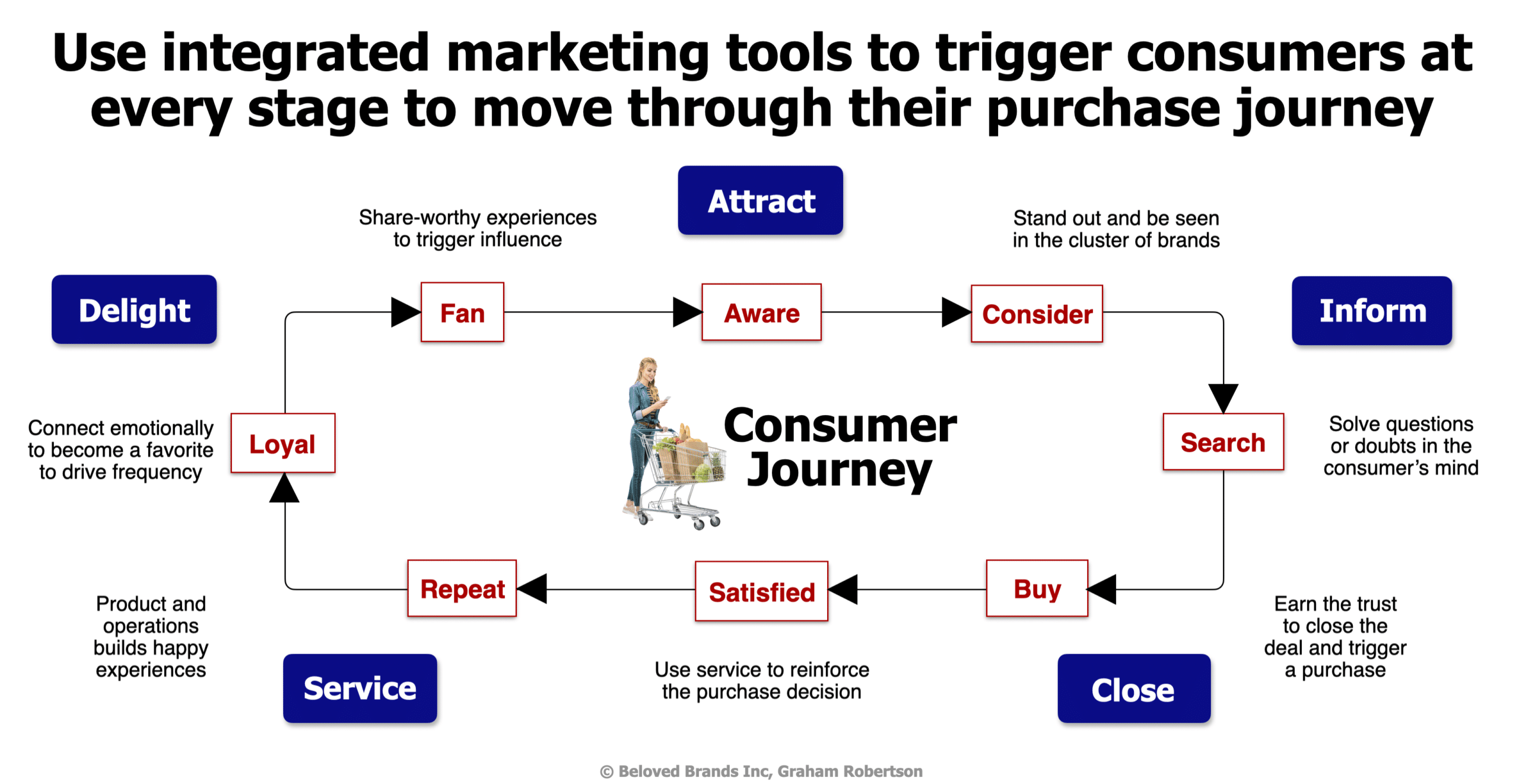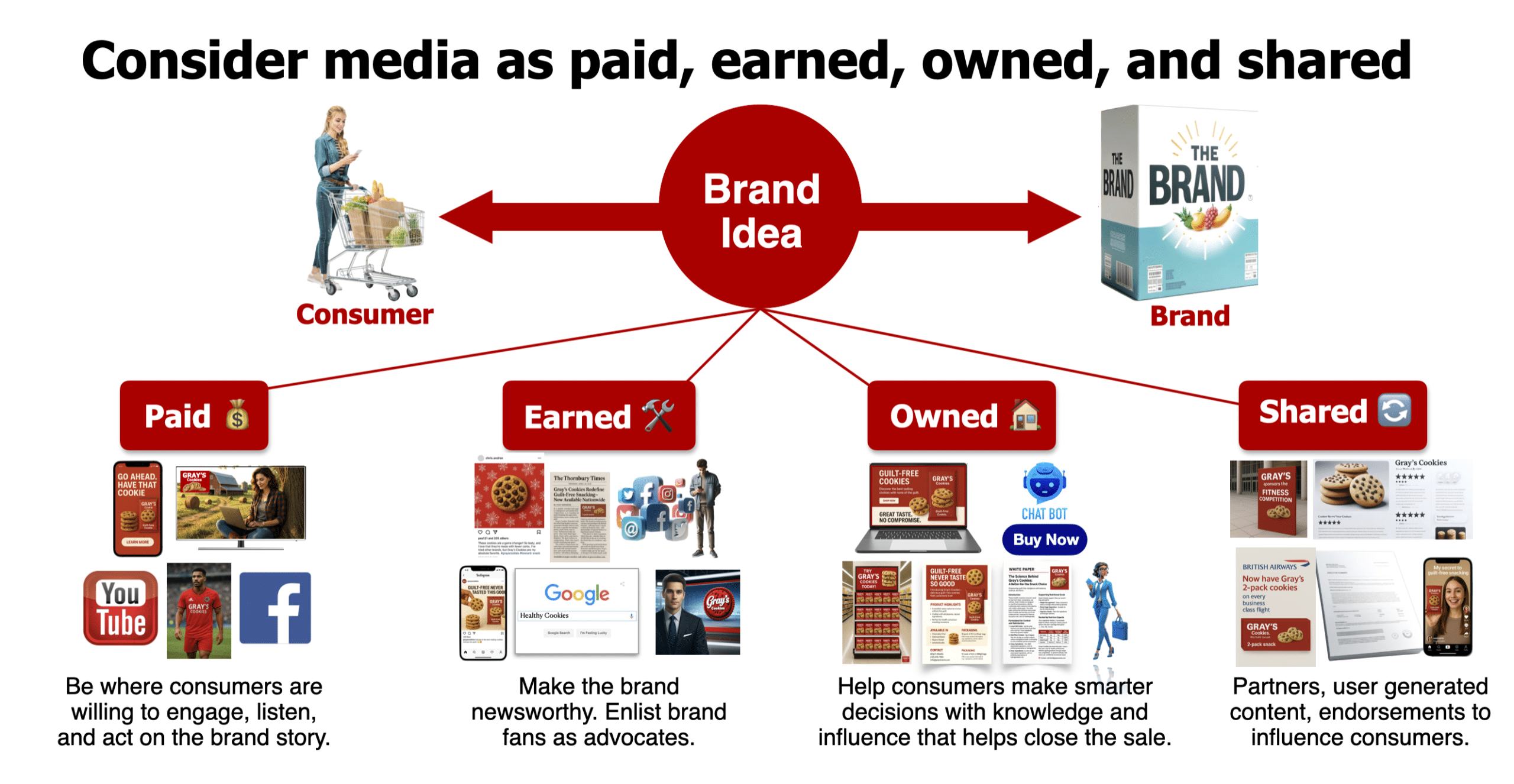Consumer marketing is a highly competitive place, where the brand leader is involved in every aspect of the business. Coming up with the advertising. Working with the new products team on innovation. Partnering with sales to get on the shelf. Running the P&L, sales forecasting, cost of goods, budgets. Everything you need to know for a career in brand management. You have to know everything about your consumer. For consumer marketers, we teach how to think strategically, how to use brand positioning, how to build a marketing plan, how to make marketing execution decisions, and how to analyze the brand.
Regardless, consumer marketers must use their brand positioning to establish a reputation and create a bond with consumers. Consumer decisions are highly emotional, yet I still see too many consumer brands focus on features and claims as the main differentiator. There is a big opportunity to build a bond with consumers and try to get them to build your brand into moments of their life.
I bring a lot of experience with consumer marketing, working at Coke, General Mills, Pfizer and Johnson and Johnson. It felt lucky to work with many great people on many great brands. I want to share that experience so others can benefit from what I’ve learned. As a consultant, I have worked with many consumer brands, including food, beverages, retail, consumer health, travel, restaurants, automotive, and beer. Clients have included National Geographic, Keurig Dr Pepper, Jack Links, Reebok, Honda, Bush’s, Smirnoff, and Indeed.
Consumer Marketing - Table of Contents
Are you a consumer marketer?
Learn how to think, define, plan, execute, and analyze.
To define a consumer brand, I will provide a tool for writing a brand positioning statement, and a consumer profile. Then, we introduce our consumer benefits ladder with lists of potential functional and emotional benefits to kickstart your thinking on brand positioning.
We explore the step-by-step process to develop your brand idea and bring it together with a tool for writing the ideal brand concept.
Building the brand plan.
Consumer marketers must know how to build their brand plans. I provide formats for a long-range brand strategy roadmap and the annual brand plan with definitions for each planning element. From there, I show how to build a brand execution plan that includes the creative brief, innovation process, and sales plan. I provide tools for creating a brand calendar and specific project plans.
To grow your brand, I show how to make smart decisions on execution around creative communications and media choices. I provide all the tools you need to write a deep-dive business review, looking at the marketplace, consumers, channels, competitors, and the brand. Write everything so that it is easy to follow and implement for your brand.
You will learn everything you need to know to run your brand.
We have translated most of our brand tools into brand management templates in downloadable PowerPoint presentations that you can purchase at beloved-brands.com
My brand promise is to help make you smarter so you can realize your full potential in your career. The big difference with our Consumer Marketing Training program is that every example I use will be a consumer brand.
To illustrate what consumer marketers must know, click to zoom in what it takes to succeed in brand management
Strategic Thinking
Strategic thinkers see questions before they see solutions
Ever hear someone say, “That’s a good question?” It usually means someone has just asked an interruptive question, designed to slow everyone’s thinking, so they reflect and plan before acting.
The strategic thinking side of marketing is logical and has to map out a range of intersecting decision trees by imagining how events will play out in the future. There is a risk of being too strategic if you think too long, you may spiral around, unable to decide. Moreover, you may miss an opportunity window.
Everyone says they are strategic thinkers, yet few are. I confess that I was more of an instinctual marketer early in my career. Consumer marketers need to slow down and organize our thoughts to learn strategic thinking. We look at five elements of strategic thinking, including the vision, strategic program, focused opportunity, market impact, and performance result.
To help consumer marketers, we have created a flywheel where the strategy keeps fueling more power and profit.
To illustrate how consumer marketers should think, click to zoom in.
Using Gray's Cookies to demonstrate strategic thinking
In this CPG (consumer packaged goods) case study, Gray’s Cookies is a great tasting, low calorie, low fat cookie alternative to your favorite cookie. A classic brand management situation.
Gray’s Cookies started as a product-led brand, but it met a ceiling on growth. The cookie market is cluttered. There are signs the product has been fully accepted, but the brand idea has yet to connect. Gray’s cannot gain enough share if it is perceived as the next best product.
The open space is an idea that combines the physical and psychological elements of diets—focusing helping get past the guilt of cravings.
Like many new brands, Gray’s Cookies has some consumers who love them already, but with the vast majority of the market, Gray’s is rather unknown. Even with those who love, stated loyalty is high, but usage frequency is far below the mainstream cookies.
Five elements of smart strategic thinking using our Gray’s Cookies example:
1. Set a vision of what you want
Gray’s wants to be the first healthy cookie to generate the craving, popularity, and sales of a mainstream cookie. The company wants to make Gray’s a $100 million brand by 2022. Like many new brands, is how to drive trial while closing gaps.
2. Invest resources in a strategic program
At the rapid growth stage, Gray’s needs to build a strong bond with consumers, and address the distribution gaps while battling any mainstream brands who could enter the healthy cookie segment.
3. Focus on an identified accelerator
Gray’s Cookies recognizes the opportunity created by the consumer shift to healthy choices. If they can take the dominant power player role in the healthy cookie segment, they can drive a high market share in a rapid growth category segment.
4. Leverage a breakthrough market impact and performance result
Gray’s Cookies is the dominant power player in driving high trials and significant market share results to gain additional shelf space in retail stores. Gray’s will bring mainstream cookie users over to drive higher sales and establish itself as the dominant “healthy cookie” brand.
How to turn smart strategic thinking into strategic objective statements
Now, let’s look at turning your smart strategic thinking into writing a strategic statement that can provide specific marching orders to everyone who works on the brand. Writing strategy is an essential skill for consuemr marketers to know.
The process covers all five elements of smart strategic thinking. You can see that the brand vision and key issue statement cover the first strategic element. However, you need the strategic objective statement to cover the remaining four other strategic elements, including the program investment, focused opportunity, market impact, and the performance result.
To illustrate brand strategy to help consumer marketers, click to zoom in. Essential to know in brand management.
Here’s how that consumer strategic statement breaks down:
Program investment:
- The strategy statement calls out the investment in a strategic program, with crystal clear marching orders to the team, leaving no room for doubt, confusion, or hesitation. In this example, the strategic program is to “Communicate Gray’s new ‘guilt-free’ positioning to new consumers.”
Focused Acclerator:
- A breakthrough point where the brand will exert pressure to create a market impact. In this example, the focused accelerator is “to meet the changing needs of proactive preventers.”
Market impact and performance result
- Achieves a specific desired market impact with a stakeholder you will attempt to move, whether it is consumers, sales channels, competitors, or influencers. In this example, the desired impact is to “attract and tempt them to try Gray’s.to drive higher market share.”
Writing your brand strategy statements
This unique strategic model will force you to pick answers to build a strategy statement with marching orders for those who follow your plan. As you develop your brand plan, I recommend using these four elements of smart strategic objective statements to ensure you structure the thinking.
Below is how we teach writing strategy statements in our Consumer Marketing Training program
The strategic program addresses what you are investing in and the target? And, focus provides a distinct opportunity to take advantage of. A market impact maps out the desired response as you move the consumers along their journey. And, the performance result harnesses the power or profit.
To illustrate how consumer marketers must write strategy, click to zoom in. Essential to know in brand management.
Brand Positioning
How to define your brand positioning to set up your brand to win
If you do not define your brand, then you run the risk of the possibility that your competitors will define your brand. And you might not like it.
I will show you the homework you must do to figure out a winning brand positioning statement. The tools are designed to help decide who your brand will serve and what you will stand for as a brand. Narrow the target to those consumers who are most capable of loving what your brand does best.
I will show you how to find the ideal balance between the functional and emotional benefits, to find which ones are simple, interesting, motivating, and ownable for your brand.
Below, click to zoom in on our consumer brand positioning process. If you work in brand management, you’d better understand brand positioning.
To illustrate what consumer marketers must know, click to zoom in.
Brands have four choices: be better, different, cheaper, or else not around for long.
As you create your brand positioning statement, look for the ideal space to play and space your brand can win. Your brand might be fast, but if your competitor is even faster, then you will lose out if you try to play in that space.
Defining the ideal target market
Most marketers think of the type of consumers they want to attract. Why not change your thinking and go after those consumers who are already motivated by what your brand offers? So instead of asking, “Who do we want?” you should be saying, “Who wants us?”
I use seven fundamental questions to define and build a profile of your ideal consumer target:
- Description of the ideal target?
- What are their main needs?
- Who is their enemy who torments them every day?
- What are the insights we know about the ideal target?
- What does they think now?
- How do they buy?
- What do we want them to see, think, do, feel or whisper?
Using the consumer benefits ladder for consumer brands
Once the consumer profile has been completed, brainstorm all possible brand features that give your brand a competitive advantage. Move up to the functional benefits by asking, “So, what do I get from that?” Then move up to the emotional benefits by asking, “So, how does that make me feel?”
To help brand leaders, I have created benefit cheatsheets with over 50 potential functional benefits and 40 potential emotional benefits. We show how to build your brand positioning around the right benefits. Then, add in the ideal reasons to believe that allow you to complete the brand positioning statement. Below is the brand positioning statement for Gray’s Cookies
To illustrate what consumer marketers must know, click to zoom in.
Brand Positioning video lesson
Marketing in about 60 seconds
Our brand positioning statement video shows how to use our functional and emotional benefit cheatsheets to help build the ideal brand positioning statement.
If you work in brand management, you’d better understand brand positioning.
To view, use the ▶️ controls to play or volume buttons
Consumer brand positioning examples
To illustrate, click on any of the brand management examples above. Essential to know in brand management.
Building your brand idea
To me, the brand idea simplifies everything, not just for the consumer or channel customers, but for everyone working on the brand. The dictionary definition of the word “idea” means a thought, opinion, belief, or mental impression. A brand idea must be all those things. Consumer marketers must know how to define their brand idea. Describe the products or services. What is the consumer reputation? What about influencer reputation? Cultural inspiration? And, then figure out the brand idea.
To illustrate what consumer marketers must know, click to zoom in.
Brand idea checklist
For consumer brands, find a brand idea that is interesting enough to engage and entice consumers on a first encounter to want to know more. Keep it simple enough to gain entry into the consumer’s mind.
Your idea must be easily layered to organize everything you do to match up with the five consumer touchpoints, including the brand promise, brand story, innovation, purchase moment, and consumer experience.
Build a brand reputation
The idea must be unique enough to build a reputation so consumers will perceive the brand as better, different, or cheaper. Your brand idea must be able to motivate consumers to think, feel, and act in ways that benefit your brand. The idea must represent the inner brand soul of everyone who works on the brand, inspiring employees to deliver the brand promise and amazing experiences.
Finally, the brand idea must be ownable so no other competitor can infringe on your space, and you can confidently build your brand reputation over time.
Alcohol example of a Brand Idea
Tourism example of a Brand Idea
Consumer Healthcare example of a Brand Idea

To illustrate, click on any of the examples above. Essential in brand management.
Brand Plans
Consumer marketers must look at the plan as a decision-making tool that guides everyone who works on the brand. We teach how to come up with the brand vision, purpose, goals, key issues, strategies and marketing execution plans. If you are a consumer marketer, you need to know how to build a plan.
To illustrate the consumer brand plan process, click to zoom in. Essential in brand management.
As you write the annual brand plan, use the vision to steer the decisions. Then lay out the key issues and strategies as the guts of the plan. Lay out in a one pager. Or, use our Consumer Brand Plan template presentation.
Analysis:
The analysis section lays out the summary from the deep-dive business review with an overview of the top three points, which envelop what is driving your brand’s growth, what is inhibiting your brand’s growth, which threats could hurt your brand and what opportunities your brand faces.
Key issues and strategies:
The key issues and strategies section focuses on the top three issues getting in the way of achieving your vision, which you should put in question format. Moreover, the strategic solutions are the answers that match up to each of those questions. Set goals to measure your brand’s performance against each strategy.
Execution section:
The execution section maps out the specific plans for each of the chosen execution areas that aligns with the most essential consumer touchpoints.
To illustrate how to do a consumer Marketing plan, click to zoom in.
I first came up with this “brand plan-on a page” format when I led a team with 15 brands. It helped me see the big picture quickly, rather than having to hunt through a big thick binder. Also, the sales team appreciated the ability to see the entire plan on one page quickly. Most salespeople also had 15 brands to manage with each of their customers. Everyone who works on your brand should receive the one-page plan and keep it close by to steer their day-to-day decisions.
Brand Plan example - Consumer Healthcare
Brand Plan example - Apple
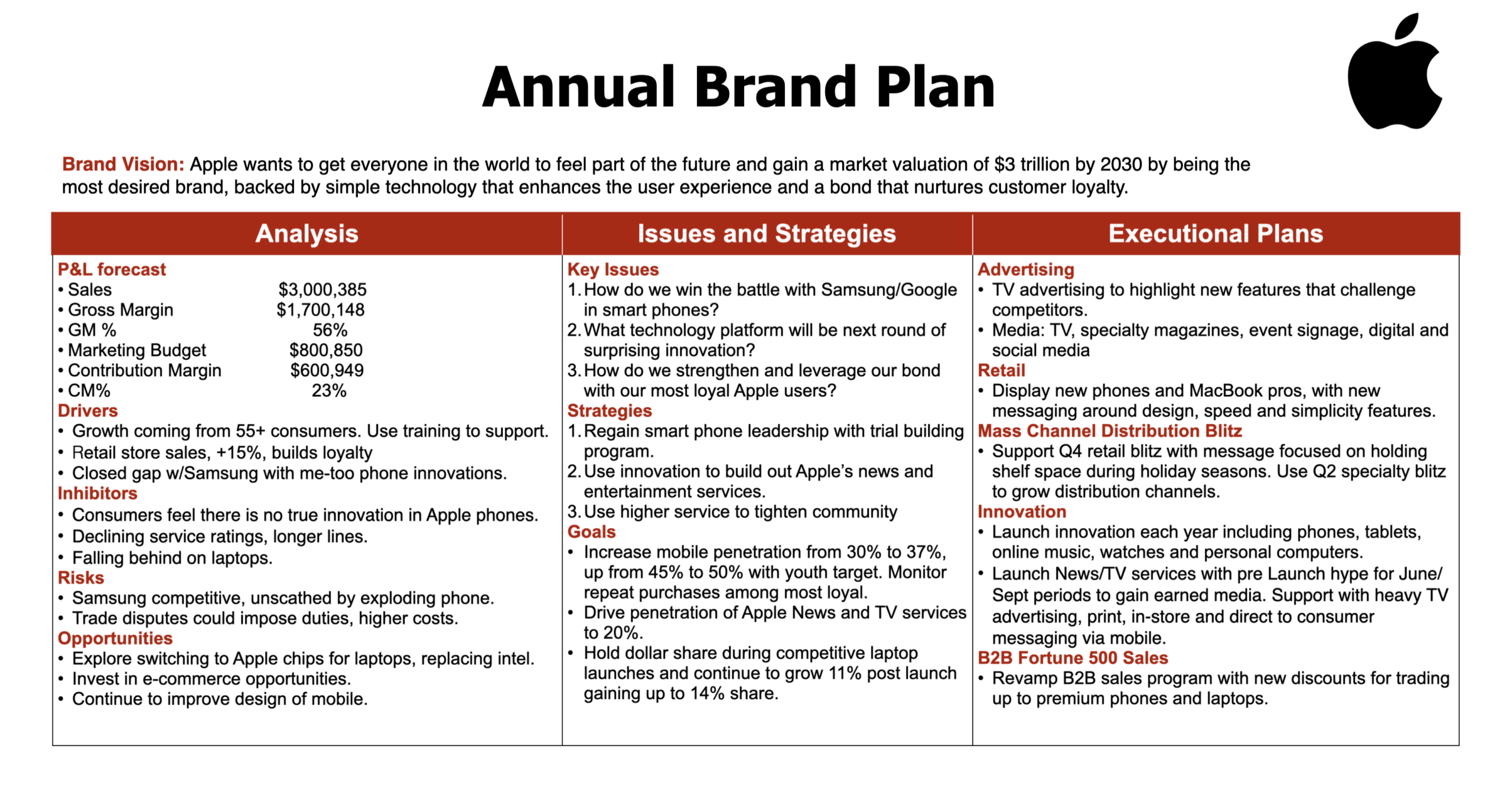
To illustrate, click on any of the brand management examples above.
Brand Plans video lesson
Marketing in about 60 seconds
Here are five simple questions to help you kickstart your first thoughts about your brand plan and decide on the big-picture elements of your plan before fine-tuning and perfecting the writing. (JWT planning guide, by Stephen King)
To view, use the ▶️ controls to play or volume buttons
Consumer Journey
While we talk a lot about consumer-based social media options, we are seeing bigger opportunities for consumers brands. It allows us to find prospects and move them through their journey. We look at attract, inform, close, service and delight.
Attract and inform
To drive awareness, you need your marketing communications to stand out and be seen in a crowd using messaging that balances being creatively different and strategically smart. When your messages are smart but not different, they get lost in the clutter. On the other hand, when your messages are different but not smart, they will entertain consumers, but do nothing for your brand. Your communications must be smart enough to trigger the desired consumer response to match your brand strategy.
To move consumers to the consideration stage, use influencers to teach those who seek to learn more. Use public relations to make the brand part of the industry news, whether through traditional, social, or blogger channels. Engage online user reviews or industry-specific review sites.
For more complex or higher risk purchase decisions, many consumers will rely on search for almost everything, even if to confirm what makes sense. Consumers marketers can use search sites, such as Google, expert review sites, and online content or long copy print media.
Over the last decade, I see a shift where consumers prefer to take the time to do their own research rather than a face-to-face call from a sales rep. Think of how you now buy a car. You do all the work before you get to the dealer. The brand website comes into play and should include the right information to close off gaps or doubts, then move consumers towards the purchase decision.
Servicing through account based marketing
Account-based marketing (ABM) can be used to move consumers along their purchase journey to help trigger an initial purchase with displays, trial programs, or sales materials to prompt consumers. Remarketing is a great tool to push consumers who might feel stuck at the consideration stage to reconsider and buy.
After the purchase, use the account-based marketing to turn usage into an early purchase into a ritual among your most loyal users. Cultivate a collection of brand fans, using VIP programs and experiential events with exclusive deals — layer in emotional marketing communications to tighten the bond.
Delighting those who love the brand
Once you have a strong base, you can mobilize your brand lovers by intentionally creating shareable experiences, which will trigger brand lovers to share your brand communications with their network through social media. With the new social media tools, the smartest brands are getting their most engaged consumers to drive awareness by sharing your message – and even enthusiastic user-generated content.
As you shift to engaging individuals, recognize the stage they are at, and then match up your marketing communication to their specific needs.
Beloved Brands Marketing Training program
Our consumer marketing training will make your marketing team smarter so they deliver their best possible performance on your brand. At Beloved Brands, we empower the ambitious consumer marketers to achieve the extraordinary. Below is our brochure for our training programs. If you work in brand management, this is your course.
We will make your marketing team smarter
Invest in our Beloved Brands Marketing Training today and start seeing an immediate impact with smarter solutions, better work, and stronger results for your team.
- We build essential Marketing Skills: Our Beloved Brands Marketing Training will equip your marketing team with the essential marketing skills to meet your expectations, including brand analytics, strategic thinking, brand positioning, strategic planning, and marketing execution.
- Marketers will work on their own brand: We impact your marketing team’s on-the-job performance by ensuring your marketers apply every new tool, method, and skill directly to their brand.
- Our marketing coaching is like having a VP in the room: Our hands-on coaching replicates real-world challenges, with your marketers experiencing the pressure and expectations they face in a boardroom
- Tailored Training Programs: We provide specialized marketing training tailored to different business models, including Consumer, B2B, Retail, and Healthcare brands. Our industry-specific examples demonstrate how easily our tools work on a brand like the marketer is working on.
To view, use the arrow to see our Beloved Brands Marketing Training program video.
Our Beloved Brands Marketing Training targets the 5 pain points that hold marketing teams back, empowering them with strategic skills, practical tools, and hands-on coaching to excel in today’s fast-paced marketing world
- When your marketing team does not analyze deeply enough, they will write or speak with random opinions rather than a reality of what’s happening. We teach how to use brand analytics to inform strategic thinking and gain agreement on the unique underlying situation.
- When your marketers jump straight to tactics, you know they are missing the underlying strategic issues holding the brand back. We teach strategic thinking by discovering smart strategic questions that frame the brand’s unique circumstances before they look for solutions.
- If your marketers try to be everything to everyone, you know they will create a brand that ends up being nothing to everyone. We teach how to define brand positioning by focusing on a consumer target and leveraging functional and emotional benefits to set up the brand to win.
- When your marketers try to do too many things in their brand plans, you know that every idea needs more resources to make the impact they expect. We teach how to write a brand plan that links each planning element to a market impact that drives performance results.
- If your marketing execution is not aligned with strategy, everyone works in silos, and the consumers will see a disjointed and confused brand. We teach how to make marketing execution decisions to find ideas that communicate with your target, align with the brand, clearly communicate the brand message, and stay consistent with the strategy.


